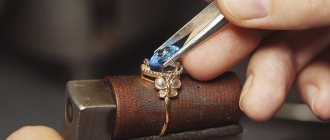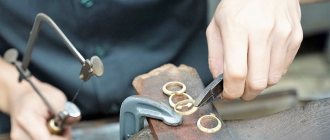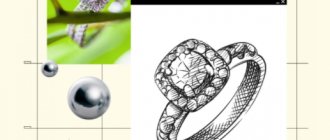Author: ProfGid
A jeweler is a master who creates jewelry and products from precious and semi-precious stones, gold, silver, enamel and other metals. Specialists work in specialized workshops and manufacturing plants, repair jewelry, and develop their design. We talk about what subjects you need to take to become a jeweler, where and what programs to study after 9th and 11th grades. By the way, in 2022, the ProfGid career guidance center developed an accurate career guidance test. He himself will tell you which professions are suitable for you, and give an opinion about your personality type and intelligence.
- Career Guidance Test
Find out which professions are suitable for you and what personal qualities contribute and hinder this.
Where to go to study to be a jeweler
You can become a jeweler after 9th or 11th grade; corresponding training programs are open at universities and colleges. University students study at the faculties of fine arts and folk crafts. You can take courses or enroll in a jewelry school, but this option should be considered as a supplement to higher or secondary vocational education (VO or VET).
Universities
You can enter universities after 11th grade, on the basis of a college or first higher education institution. Programs for jewelers are open at Moscow State Pedagogical University, Russian State University named after. A. N. Kosygina (Technology. Design. Art), GITIS, Higher School of Folk Arts (academy), St. Petersburg State University of Pedagogical Theater - in total more than 50 universities.
| Direction | Code | Qualification | Form of study | Training period |
| "Decorative and applied arts and folk crafts" | 53.03.02 | Bachelor | Full-time | 4 years |
| Part-time | 5 years |
Colleges
Colleges offer a large number of training courses for jewelers. You can enroll after grades 9 and 11, as well as on the basis of secondary vocational and higher education. The programs are implemented by the Carl Fabergé College of Decorative and Applied Arts, College of Entrepreneurship No. 11, College of Architecture, Design and Reengineering No. 26.
How to become a jeweler: where and how long do you need to study jewelry making?
Since ancient times, people have processed natural materials and made jewelry from them. Over time, the process of creating accessories improved, and with the invention of special mechanisms, jewelry began to resemble real works of art.
Today, the profession of a jeweler is considered quite in demand, since the production of jewelry is a complex and delicate work.
Who is a jeweler: what do you need to know about the profession?
The main task of a jeweler is to make jewelry. Often, craftsmen also provide jewelry repair services, adjusting the sizes of rings, bracelets or chains.
The specialist is helped in his work by many tools - jigsaws, files, soldering irons, magnifying glasses. Sometimes, when performing complex original works, completely new devices and mechanisms of original production are used.
In his craft, a jeweler uses precious and non-ferrous metals, precious and semi-precious stones. When creating an artistic product, common techniques include forging, casting, artistic embossing, carving or engraving.
Tasks and Responsibilities
The specialist's responsibilities will depend on his qualifications. Thus, an engraver engraves jewelry made of precious metals, and an assembler mounts parts of the product, connecting it into a single whole.
Regardless of his main functions, a jeweler must be able to describe the precious metals, stones and other materials used, as well as the various methods of processing them. The master must be able to read the drawings of the products being created and know GOST standards.
Work and salary
Beginners in the jewelry business begin their professional journey in factories or factories, where they can grow to a 7th grade jeweler. The most experienced and talented specialists open their workshops and participate in international exhibitions.
Jewelers have enough opportunities to advance their careers, but even at the initial stage, the salary of such a specialist will be high - from 50,000 rubles, depending on the place of work.
Pros and cons of the profession
Working as a jeweler has its advantages and disadvantages. The advantages of this profession include:
The disadvantages are often highlighted:
How to learn to be a jeweler?
There are several ways to master the profession of a jeweler. Some graduates enter a secondary school or higher education institution in order to obtain a solid knowledge base that will allow them to expand their future field of activity. Others choose to study with a practicing master or study on their own. Often, if a newcomer to this field has basic knowledge and skills, as well as initial experience, it is possible to work as a jeweler without specialized education.
What skills are needed?
Representatives of this profession know the rules of working with materials, types of precious stones, and their physical properties. They also know the basics of sketching, drawing, decorating and engraving.
For this specialty, it is mandatory to have a developed artistic taste and a creative approach to work. A jeweler must have perseverance, attentiveness, be scrupulous, and also have a penchant for working with his hands and excellent eyesight.
What education is needed and where can I go?
Jewelry making is a fairly popular specialty in higher education institutions. In order to become a master, you should choose the direction “Jewelry Making”, “Decorative and Applied Arts”.
Those who wish to master this craft can study at a secondary specialized educational institution or university.
What subjects need to be taken?
To enter a higher education institution or secondary school, you will need to pass a unified state exam in the form of testing. Most often, graduates demonstrate their knowledge of the Russian language, history, and mathematics. The educational institution may also require you to take part in a creative drawing or drawing competition.
How long does it take to study to become a jeweler after grades 9 and 11?
Studying at a higher educational institution in specialty programs takes 5 years, after which the graduate can already work in specialized companies. After 9th grade, an applicant will master a craft in colleges or technical schools for 2-3 years, depending on the training program of a particular secondary school.
Is distance learning possible?
Many commercial educational institutions offer distance learning in jewelry making. Such training programs are designed for accomplished specialists who want to improve their level of knowledge and undergo retraining.
Where can I get training in jewelry making?
Many educational institutions in Russia provide the opportunity to master the profession of a jeweler.
Universities and academies
You can study to become a jeweler at higher educational institutions in Moscow.
Some universities in St. Petersburg also offer a similar specialty.
Colleges and technical schools
Graduates of 9th grade can receive basic training at Moscow colleges and technical schools.
It is possible to complete secondary specialized education after 9th grade in the direction of “Jeweler” in St. Petersburg.
Jewelers courses
Moscow offers a wide range of courses for jewelers.
There are similar programs in St. Petersburg.
Thus, the profession of a jeweler is creative, creative and interesting. These specialists can work in private workshops, factories, and jewelry stores. They also make good appraisers and employees of expert bureaus.
Source
Entrance exams
When entering a university or college that has programs for future jewelers, you must pass a creative test (for most areas of training). Eleventh grade graduates must pass the Unified State Exam, and 9th grade graduates must successfully complete a certificate competition.
Higher education institutions
A specialist in the field of jewelry will have to not only make jewelry, but also develop designs and draw sketches. The level of artistic skills during the introductory campaign is determined by a creative test. Upon admission to the Institute of Culture and Arts of Moscow State Pedagogical University and Russian State University named after. A. N. Kosygina (Technology. Design. Art) will need to pass a test in drawing, at the Moscow branch of the Higher School of Scientific Research - in drawing and painting. The conditions of the DVI must be clarified at the selected educational institution.
| Direction | Profile subject of the Unified State Examination | Items to choose from |
| "Decorative and applied arts and folk crafts" | Literature | Social science Story Foreign language |
Profession of a jeweler: what skills does a master need?
Even in Ancient Egypt, there were craftsmen who created jewelry and artistic products for the pharaohs and priests. Today this luxury has become available to almost everyone, and is considered one of the most popular and valuable gifts.
The profession of a jeweler combines technical and creative principles. It is important for a specialist to know the characteristics of metals and stones, master material processing techniques, and be able to draw and draw. All these skills, combined with a subtle artistic taste, are practically translated into jewelry.
Behind beautiful things there is very delicate work, which includes separate stages. They can be performed either by a generalist jeweler or by a team of more specialized specialists. First, the master creates sketches of the future product, which, with the help of computer programs, acquire a three-dimensional appearance. The next step is to grow a prototype product from polymer plastic or print it on a 3D printer. Using the prototype, the master makes a special mold for casting the jewelry. At the final stages, all that remains is to fix the inserts or stones and polish them.
If you need to make a personal decoration, then an engraver will do the inscriptions. Securing inserts into jewelry is the prerogative of the setter. The openwork patterns are made by a filigree maker, and the final processing of the jewelry is entrusted to an assembler. There are jewelers who only deal with bracelets, chains or art pieces
Career prospects
During their studies, all Istituto Marangoni students collaborate with fashion houses in Italy, which gives them the opportunity to gain experience and make professional contacts. In addition, much attention is paid to management skills and market research - the university trains not just artisans, but proactive creators who are ready to put their ideas to work.
Based on the results of the training, the institute organizes public screenings and meetings with key industry players. For many, graduation is already the beginning of a successful career.
Interesting Facts
Jewelry craftsmanship has a rich history, during which many interesting events took place:
- A necklace made of mollusk shells is considered the oldest piece of jewelry : according to experts, the age of the product is at least 115 thousand years.
- The founder of the Cartier brand is the first master who used platinum to create jewelry. Previously, coins were mainly made from metal.
- Working with precious materials requires calmness and scrupulousness from craftsmen, therefore, before entering educational institutions, applicants are required to undergo examination by a narcologist and psychologist.
- The profession of a jeweler is considered hereditary , which is passed on from generation to generation - usually the fate of a child in such families is already predetermined from childhood.
- The most valuable jewelry is considered to be those found on the ocean floor after the Titanic disaster. The collection includes: necklaces, pins, brooches, rings and, of course, the most important thing – the “Heart of the Ocean” necklace, which can be seen on the heroine of James Cameron’s film.
- Due to its plasticity, gold quickly loses its shape, so it is never used in its pure form, but is alloyed with other metals.
- The dark blue Wittelsbach diamond is the most expensive in the world - its cost is approximately $80 million.
Jewelry craftsmanship is a real art. Despite the high work requirements and existing disadvantages, this profession remains one of the most in demand, creative and highly paid in the world.
How to choose a course
Dozens of choices of schools and studios are overwhelming. To choose effective jewelry courses , we recommend looking at the following points:
- Goals: do you want to repair products, work from someone else’s sketches, or create your own.
- How many years has the school been operating?
- Availability of a license to carry out educational activities.
- Find out about the teachers: experience, skills, products.
- Works of graduates.
- Reviews on forums and social networks. Pay attention to how the school reacts to outside opinions: they explain whether cases are examined. Or they ignore complaints.
- View more prices to get the average price. Compare the cost of approximately the same number of classes and program content. Sometimes the high price is justified by a well-known brand, teachers, or expensive rent in a posh center.
- The school may be named after a well-known person in the community. Be careful: often this is only a name. It is not necessary that the master conducts the classes. Especially for beginners.
- Find out if the school offers open or trial lessons. During such visits, you can evaluate the school’s equipment and teaching methods.
- For job opportunities, look for courses that will lead to a certificate or rank.
- A big plus is the possibility of employment.
Pay attention to the important points for you: how comfortable it is in the workshop, work schedule, common language with the teacher. Studying is productive when it is fun.










